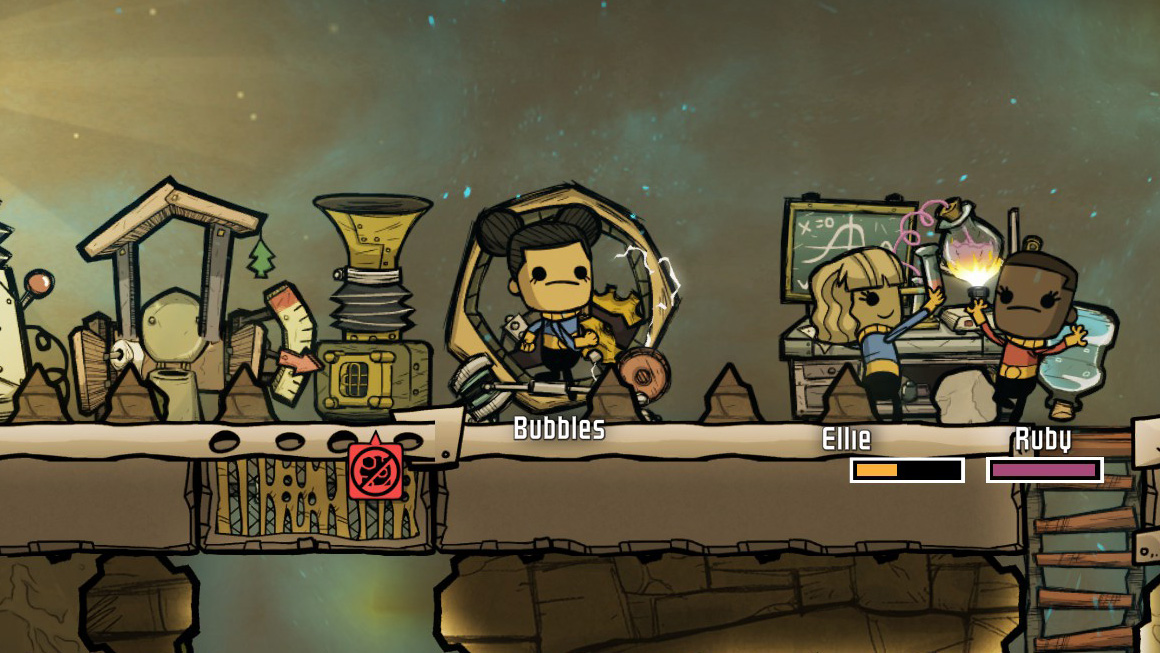Oxygen Not Included is a deep and complex sim that's also easy to jump into
Klei's colony-builder, now in Early Access, is fun and immediately accessible, yet wonderfully complicated.
Ellie, my researcher, has hit a wall. Literally, I mean. Completely stressed out, she's left her work station and is running around the colony, punching random blocks with her fists, slamming her head against them in frustration, and pausing periodically to try to compose herself (and failing) before continuing her rampage. As she dashes around in a blind rage she even delivers a few vicious blows to the colony's manual power generator (it's like a huge hamster wheel) before another, more level-headed colonist hurriedly steps in to make repairs. Eventually Ellie runs over to the massage table, where I'm happy to see that rather than punching it to pieces, she climbs aboard for a stress-relieving mechanical back-rub. The Ellie problem has been temporarily resolved but a new issue crops up: Otto, another colonist, has gone from stress burping to stress vomiting. That's probably not a good sign.
I'm in my third hour of play, and things have begun to fall apart after mostly smooth sailing during hours one and two. Oxygen Not Included, now in Early Access, is a management simulation from Klei Entertainment (developer of Don't Starve) in which you direct a handful of brave clones to build an underground base in an asteroid. You need to manage your colonists as they dig out caverns, gather resources, build machinery, and turn a harsh environment into a livable underground home. As you may have gathered from the title, not only do the colonists need food, warmth, and comfort, but also enough clean air to breathe. And clearly, you need to keep on eye on their stress levels—which can rise due foul odors, full bladders, lack of sleep, and other factors—because like Ellie they can to go a little nuts, or in Otto's case, simply start barfing on everything.

I've decided not to consult any wikis during my first session: I've grown a bit weary of the endless alt-tabbing and hours of reading that typically accompany these Early Access survival games. Oxygen Not Included, thankfully, does a good job of explaining most of its basic features in menus, mouse-over tips, and unobtrusive tutorial notifications, and the information you need to get started is easy to come by right there in the game.
I'm also learning a lot through simple observation. I can see that gases like oxygen and hydrogen float upwards, while others, such as carbon dioxide, settle downwards. As these gases concentrate, float, and swirl, you can easily tell what is breathable and what is dangerous without the colored mists completely obscuring everything else, and there are helpful overlays you can toggle to get an idea of trouble spots. There are certainly challenges in solving the issues of toxic gases mingling with breathable oxygen, but at least it's easy to see those issues in the first place. Water, meanwhile, flows and pools thanks to gravity, but not entirely smoothly: due to surface tension it may cling to rocks or narrow tunnels. Water, naturally, is prone to pollution as well, and can be a hazard like tainted air is. I learned this the hard way when one of my clones couldn't make it to the bathroom in time, and spread piss all over the research area. Way to go, Leon.
There are various mechanical items you can unlock through research, like liquid and gas pumps and pipes to direct helpful elements like water and O2 where they need to be, and pump away chlorine gas and other pollutants. Electricity for these machines begins with a manually operated generator (the human hamster wheel), with batteries to store surplus power power and wires you can string around the base to link the machinery. Once you've begun to research new technology you can also build generators powered by coal, natural gas, and hydrogen. Building something is as simple as selecting what you want and plopping it somewhere, while icons and text clearly identify any missing requirements.
It's tricky, though, dealing with those gases. After building my hydrogen generator in a pocket of gas in a nearby cavern, I noticed a colonist was constantly running over to repair it. My pump was also pulling in chlorine, which was plentiful in the same cave and was damaging the generator. As more hydrogen got used for the generator, chlorine filled the space to take its place, causing my generator to break down even more often. I added a filter that would separate the two gases (though I'm not entirely sure I hooked it up properly) and walled most off the chlorine with solid tile.
Then the small space ran out of hydrogen altogether and became a vacuum, shutting the generator down again. I had a colonist destroy an airlock so the pump could use the remaining amount of hydrogen that was present in the generator room, which kept the genny running a bit longer until that space was empty, too (though there was some leftover chlorine swirling around, causing more damage). Then it shut down for good. Time to look elsewhere for my hydrogen.
The biggest gaming news, reviews and hardware deals
Keep up to date with the most important stories and the best deals, as picked by the PC Gamer team.
I had a similar problem with water, which can be used for farming and plumbing. The pump I'd submerged in one cave eventually pumped all the water out, so I dug a tunnel and laid down some pipe in another water-filled cavern, hoping to send the water into the now-empty one. A portion of my tunnel collapsed, however, sending the water flooding into my base before I'd finished connecting my pipe. Some of the water made it to the empty cave, but it also covered the floors in several areas, submerged some other machinery (which stopped working) and of course gave my colonists 'soggy feet' which tends to make them cold and unhappy.
It was a bit of a mess. In fact my colony in general is a mess, not just due to my plumbing and piping miscues but from poor planning. I hadn't provided enough venting in certain areas for the oxygen to flow properly, and I probably should have placed the lavatories (which can get plenty toxic themselves) a bit further away from the colonists' beds. Stress levels continued to rise among my little colonists as things slowly but steadily grew worse.
I'm up to seven or eight colonists (you receive new ones, called Duplicants because they're constructed by a giant 3D printer, every few days) before I decide that rather than trying to salvage my stinky, soggy base, that I should just try to start over from scratch. Time to kill everybody!
In this regard, I have to say, Duplicants are surprisingly durable. They can live a long, long time in deadly environments and keep on working even when things are really not going their way. While Ellie is losing her mind, her health remains high, as does that of all my other little workers. I have to make a concerted effort to kill them in the end (well, I don't have to, I want to, since I'm starting over anyway).
I disable all the machinery, toilets, generators, and food production and I set the colony to red alert, meaning colonists will prioritize work above all other needs, even sleep. Finally, they begin to drop. Otto stress-burps a final time before keeling over, Ellie stops rampaging and croaks, and a Duplicant called Mi-Ma pauses in her pointless task, obtains a momentary expression of bliss, then expires.
Oxygen Not Included is in Early Access, but it's already a heck of a lot of fun (and for the record, my second colony is going much better than my first). Thanks to the colonists' hearty and durable nature, the early game feels forgiving enough to let you take your time, work on your colony at a leisurely pace, and not worry about a few accidents or problems completely wiping out all of your citizens in one fell swoop.
There's a lot of complexity and the opportunity to build deep and complicated mechanical systems if that's your thing, but Klei's done a great job making the game easy to get into and grasp the basics, unlike many other survival management games. Maybe Ellie lost her mind from stress, but I haven't yet.

Chris started playing PC games in the 1980s, started writing about them in the early 2000s, and (finally) started getting paid to write about them in the late 2000s. Following a few years as a regular freelancer, PC Gamer hired him in 2014, probably so he'd stop emailing them asking for more work. Chris has a love-hate relationship with survival games and an unhealthy fascination with the inner lives of NPCs. He's also a fan of offbeat simulation games, mods, and ignoring storylines in RPGs so he can make up his own.

